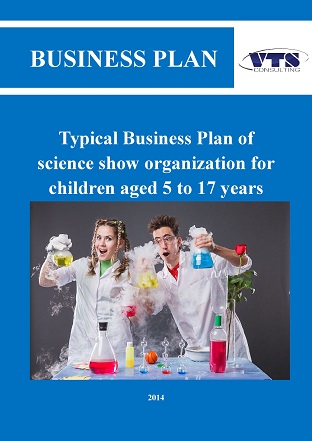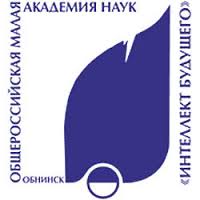
BUSINESS PLAN 'Typical Business Plan of science show organization for children aged 5 to 17 years' (with financial model)
- 139
- Английский
- 30.07.2014
- В электронном виде
-
Скачать (pdf)
- Описание
- Содержание
- Приложения
Adaptation of this business plan is possible for analogous project around the world.
The financial model in separate file is attached to this business plan, which makes it easy to build a new financial plan by entering the appropriate data.
Business plan description
Project idea
Science show is a new interesting format of performances for children and adults: a symbiosis of learning and entertainment. During performances scientists show incredible experiments, while spectators become active participants of them. Scientific laboratory will develop two lines of business: science shows and regular classes.
Establishments market of extracurricular education for children
Russia has *** state extracurricular educational establishments, in *** of which pupils study. But during recent years the tendency for the formation of private establishments has been expressed ever more clearly – about **% of parents pay for additional education services of their children. As a result, about *** % of pupils among *** thsd. are involved into additional education.
Competitors
 |
«Professor Nicola’s Shaw» (http://nik-show.ru/) |  |
«Smart Holiday» (http://umniiprazdnik.ru/) |
 |
«Crazy Laboratory» (http://madlabshow.ru) |  |
Federal Center of Technical Creativity of Pupils (FCTCP) |
 |
«Laboratory of wonders» (http://megashow.org) |
 |
All-Russian Public Organization «Small Academy of Sciences (SАS) «Intelligence of the Future» |
 |
«Academic Steklyashkin’s Incredible Science Show» (http://www.show-nauka.ru/) |
Competitive advantages of creating science show
- There are more than 100 spectacular physical and chemical experiments in the arsenal of the show.
- A new program consisting of more than ** experiments will be released every * months.
- Broadcasting of the show on TV.
- Active cooperation with research centers. The research staff of universities and experienced screenwriters will be involved in the process of new programs preparation.
- It is possible to begin the training between the ages of 5 to 17 years.
- The teachers have higher education in physics and chemistry.
- The club develops the training program itself taking into account the child's age.
Finance
|
An indicator |
A city with a population of 300-500 thsd. pers. |
A city with a population of 500 ths.-1 mln. pers. |
A city with a population of over 1 mln. pers. |
|
Necessary investments, thsd. RUB. |
*** |
*** |
*** |
|
Revenue for 3 years, thsd. RUB. |
*** |
*** |
*** |
|
Net profit for 3 years, thsd. RUB. |
*** |
*** |
*** |
|
NPV, thsd. RUB. |
*** |
*** |
*** |
|
IRR annual, % |
*** |
*** |
*** |
|
Payback period, months |
*** |
*** |
*** |
Excerpts from the research
According to the data of Federal Statistical Observation, greatest coverage of additional educational programs is typical for the age group of **–** years and **–** years and makes ** and **% accordingly.
A specific feature of children’s additional educational establishments (CAEE) is their operating mode. The results of survey showed that the establishments, where classes take place in the afternoon (** %), predominate among CAEE, classes of the third of the establishments take place evenly throughout the day accordingly, a small number of establishments operates mainly in the first half of the day. CAEE implements the programs that last during different time. The programs designed for over 3 years lasting (** %) dominate. Exactly such programs are the most effective in the context of professional and leisure self-determination of pupils. Short term programs, during which the child can try his hand in any kind of activity, are implemented by **% of CAEE.
There is a certain imbalance of demand and supply of children’s additional educational services. Competitive selection is used primarily for admission to the program of artistic direction. It is quite common to use selection instruments forming the cultural studies (** %) and sports (** %) groups of pupils. The acceptance of programs of scientific and technical (** %), ecological and biological (** %) and tourist and local historical (** %) directions is practically free.
The target audience for science shows and regular classes are Russian schoolchildren. The number of pupils of secondary schools in Russia is about *** thsd. The average number of pupils are *** schoolchildren per secondary school.
The last years it has been observed an increasing number of private structures in providing of relevant services. According to the research, only ** % of parents do not pay for additional education of their children.
The most appropriate marketing tools in promoting CAEE are creation and optimization of landing pages, contextual advertising, promotion in social networks and advertising with flyers. Monthly marketing budget in cities with a population over 1 mln. people is planned in the amount of ** thsd. RUB, in cities with a population of 500 – 1 000 thsd. people – ** thsd. RUB and in settlements with a population of 300 – 500 thsd. people – ** thsd. RUB. The initial capital investments for each type of settlement vary according to such principle too.
List of tables, charts and figures...................................................................................................... 5
Tables.......................................................................................................................................... 5
Charts.......................................................................................................................................... 7
Figures....................................................................................................................................... 10
Executive summery........................................................................................................................ 11
- Description of Project ............................................................................................................... 13
1.1. Socialization peculiarities of children, adolescents and youth in the field of leisure........ 13
1.2. General characteristics of the creating science show......................................................... 14
1.3. Safety................................................................................................................................. 17
- Market analysis.......................................................................................................................... 18
2.1. Market analysis of establishments of extracurricular education in Russian Federation
.................................................................................................................................................. 18
2.2. Market analysis of establishments of extracurricular education in Russian Federation for big cities.................................................................................................................................................. 21
2.3. Market trends..................................................................................................................... 23
- Competitive environment.......................................................................................................... 29
3.1. Major competitors.............................................................................................................. 29
3.2. State establishments........................................................................................................... 35
- Target audience.......................................................................................................................... 39
- Actuality.................................................................................................................................... 42
- Marketing strategy .................................................................................................................... 44
6.1. Ways of promotion and market entrance........................................................................... 44
6.2. Creating of landing pages.................................................................................................. 45
6.3. Optimization of landing pages........................................................................................... 46
6.4. Contextual advertising....................................................................................................... 48
6.5. Promotion in social networks............................................................................................. 49
6.6. Marketing budget............................................................................................................... 50
- Financial plan. Cities with a population over 1 mln. people...................................................... 51
7.1. Plan of sales....................................................................................................................... 51
7.2. Sales volume...................................................................................................................... 52
7.3. Revenue............................................................................................................................. 52
7.4. Variable costs..................................................................................................................... 54
7.5. Fixed costs......................................................................................................................... 55
7.6. Capital expenditure............................................................................................................ 57
7.7. Taxes.................................................................................................................................. 57
7.8. Profit and loss statement.................................................................................................... 58
7.9. Discount rate...................................................................................................................... 61
7.10. Cash flow statement........................................................................................................ 71
7.11. Financial rates.................................................................................................................. 74
- Financial plan. Cities with a population from 500 ths. to 1 mln. people................................... 75
8.1. Plan of sales....................................................................................................................... 75
8.2. Sales volume...................................................................................................................... 75
8.3. Sales revenue...................................................................................................................... 76
8.4. Variable costs..................................................................................................................... 77
8.5. Fixed costs......................................................................................................................... 78
8.6. Capital expenditure............................................................................................................ 80
8.7. Taxes.................................................................................................................................. 80
8.8. Profit and loss statement.................................................................................................... 81
8.9. Cash flow statement.......................................................................................................... 84
8.10. Financial rates.................................................................................................................. 87
- Financial plan. Cities with a population from 300 to 500 ths. people....................................... 88
9.1. Plan of sales....................................................................................................................... 88
9.2. Sales volume...................................................................................................................... 88
9.3. Sales revenue...................................................................................................................... 89
9.4. Variable costs..................................................................................................................... 90
9.5. Fixed costs......................................................................................................................... 92
9.6. Capital expenditure............................................................................................................ 93
9.7. Taxes.................................................................................................................................. 94
9.8. Profit and loss statement.................................................................................................... 94
9.9. Cash flow statement.......................................................................................................... 97
9.10. Financial rates................................................................................................................ 100
- Sensitivity analysis. Cities with a population over 1 mln. people.......................................... 101
10.1. Changing of level of prices for services......................................................................... 101
10.2. Changing of variable costs............................................................................................. 104
10.3. Changing of fixed costs................................................................................................. 106
10.4. Changing of capital expenditure.................................................................................... 109
10.5. Changing of discount rate.............................................................................................. 112
- Sensitivity analysis. Cities with a population from 500 ths. to 1 mln. people....................... 114
11.1. Changing of level of prices for services......................................................................... 114
11.2. Changing of variable costs............................................................................................. 116
11.3. Changing of fixed costs................................................................................................. 119
11.4. Changing of capital expenditure.................................................................................... 122
11.5. Changing of discount rate.............................................................................................. 125
- Sensitivity analysis. Cities with a population from 300 to 500 ths. people........................... 126
12.1. Changing of level of prices for services......................................................................... 126
12.2. Changing of variable costs............................................................................................. 128
12.3. Changing of fixed costs................................................................................................. 131
12.4. Changing of capital expenditure.................................................................................... 134
12.5. Changing of discount rate.............................................................................................. 137
INFORMATION ABOUT THE COMPANY «VTS Consulting».................. 138
Tables
|
Table 1. Science show programs (01.06.2014) |
14 |
|
Table 2. The largest city in terms of population, thsd. people |
21 |
|
Table 3. Academic Steklyashkin’s science show prices |
33 |
|
Table 4. Prices for holding of children's parties of «Smart holiday» laboratory |
34 |
|
Table 5. The main differences between the show formats of «Smart holiday» laboratory |
34 |
|
Table 6. Statistics in terms of the Russian secondary schools and schoolchildren numbers in 2012. |
39 |
|
Table 7. Marketing budget, thsd. RUB |
50 |
|
Table 8. Plan of sales |
51 |
|
Table 9. Sales volume |
52 |
|
Table 10. Sales revenue |
53 |
|
Table 11. Variable costs |
54 |
|
Table 12. Fixed costs |
55 |
|
Table 13. Capital expenditure |
57 |
|
Table 14. Taxes |
57 |
|
Table 15. Profit and loss statement |
58 |
|
Table 16. Calculation of long-term profits over CAPM for portfolios of decimal groups NYSE/AMEX/NASDAQ |
66 |
|
Table 17. Algorithm for determining the risk of the company |
67 |
|
Table 18. Algorithm for calculating the specific risk premium |
68 |
|
Table 19. Calculation of discount rate by WACC-method |
69 |
|
Table 20. Cash flow statement |
71 |
|
Table 21. Financial rates |
74 |
|
Table 22. Plan of sales |
75 |
|
Table 23. Sales volume |
75 |
|
Table 24. Sales revenue |
76 |
|
Table 25. Variable costs |
77 |
|
Table 26. Fixed costs |
78 |
|
Table 27. Capital expenditure |
80 |
|
Table 28. Taxes |
80 |
|
Table 29. Profit and loss statement |
81 |
|
Table 30. Cash flow statement |
84 |
|
Table 31. Financial rates |
87 |
|
Table 32. Plan of sales |
88 |
|
Table 33. Sales volume |
88 |
|
Table 34. Sales revenue |
89 |
|
Table 35. Variable costs |
90 |
|
Table 36. Fixed costs |
92 |
|
Table 37. Capital expenditure |
93 |
|
Table 38. Taxes |
94 |
|
Table 39. Profit and loss statement |
94 |
|
Table 40. Cash flow statement |
97 |
|
Table 41. Financial rates |
100 |
|
Table 42. Sensitivity analysis of changes in level of prices for services |
101 |
|
Table 43. Sensitivity analysis of changes in variable costs |
104 |
|
Table 44. Sensitivity analysis of changes in fixed costs |
106 |
|
Table 45. Sensitivity analysis of changes in capital expenditure |
109 |
|
Table 46. Sensitivity analysis of changes in discount rate |
112 |
|
Table 47. Sensitivity analysis of changes in level of prices for services |
114 |
|
Table 48. Sensitivity analysis of changes in variable costs |
116 |
|
Table 49. Sensitivity analysis of changes in fixed costs |
119 |
|
Table 50. Sensitivity analysis of changes in capital expenditure |
122 |
|
Table 51. Sensitivity analysis of changes in discount rate |
125 |
|
Table 52. Sensitivity analysis of changes in level of prices for services |
126 |
|
Table 53. Sensitivity analysis of changes in variable costs |
128 |
|
Table 54. Sensitivity analysis of changes in variable costs Sensitivity analysis to changing of fixed costs |
131 |
|
Table 55. Sensitivity analysis of changes in capital expenditure |
134 |
|
Table 56. Sensitivity analysis of changes in discount rate |
137 |
Charts
|
Chart 1. Dynamics of the number of extracurricular educational establishments, units. |
19 |
|
Chart 2. Dynamics of children participation in extracurricular education, thsd. people |
19 |
|
Chart 3. Coverage of children with extracurricular educational programs, % |
24 |
|
Chart 4. Share of children’s additional educational establishments, implementing programs for work with children of certain categories, % |
25 |
|
Chart 5. Share of schoolchildren and preschoolers which take part in studying in additional educational establishments free of charge, for expanse of budget funds, %. |
26 |
|
Chart 6. Mode of classes in children’s additional educational establishments |
26 |
|
Chart 7. Share of children’s additional educational establishments, implementing programs of different duration, % |
27 |
|
Chart 8. Existence of difficulties of pupils contingent selection in terms of various directions programs, according to CAEE management estimates , % |
28 |
|
Chart 9. Existence of children competitive selection in additional educational establishments in terms of various directions programs, % |
28 |
|
Chart 10. Revenue, gross profit and EBITDA for 36 months statement |
60 |
|
Chart 11. Net profit for the 36 months statement |
60 |
|
Chart 12. Revenue, gross profit and EBITDA for 36 months statement |
83 |
|
Chart 13. Net profit for the 36 months statement |
83 |
|
Chart 14. Revenue, gross profit and EBITDA for 36 months statement |
96 |
|
Chart 15. Net profit for the 36 months statement |
96 |
|
Chart 16. Net income dynamics due to the changes in prices for services, thsd. RUB |
101 |
|
Chart 17. NPV dynamics due to changes in prices for services, thsd. RUB |
102 |
|
Chart 18. IRR dynamics due to changes in prices for services, % |
102 |
|
Chart 19. Payback period (PP) dynamics due to changes in prices for services, months |
103 |
|
Chart 20. Discounted payback period (DPP) dynamics due to changes in prices for services, months |
103 |
|
Chart 21. Net profit dynamics due to changes in variable costs, thsd. RUB |
104 |
|
Chart 22. NPV dynamics due to changes in variable costs, thsd. RUB |
104 |
|
Chart 23. IRR dynamics due to changes in variable costs, % |
105 |
|
Chart 24. Payback period (PP) dynamics due to changes in variable costs, months. |
105 |
|
Chart 25. Discounted payback period (DPP) dynamics due to changes in variable costs, months. |
106 |
|
Chart 26. Net profit dynamics due to changes in fixed costs, thsd. RUB |
107 |
|
Chart 27. NPV dynamics due to changes in fixed costs, thsd. RUB |
107 |
|
Chart 28. IRR dynamics due to changes in fixed costs, % |
108 |
|
Chart 29. Payback period (PP) dynamics due to changes in fixed costs, months |
108 |
|
Chart 30. Discounted payback period (DPP) dynamics due to changes in fixed costs, months. |
109 |
|
Chart 31. NPV dynamics due to changes in capital expenditure, thsd. RUB |
110 |
|
Chart 32. IRR dynamics due to changes in capital expenditure, % |
110 |
|
Chart 33. Payback period (PP) dynamics due to changes in capital expenditure, months |
111 |
|
Chart 34. Discounted payback period (DPP) dynamics due to changes in capital expenditure, months |
111 |
|
Chart 35. NPV dynamics due to changes in discounted rate, thsd. RUB |
112 |
|
Chart 36. Discounted payback period (DPP) dynamics due to changes in discounted rate, months. |
112 |
|
Chart 37. Net income dynamics due to changes in prices for services, thsd. RUB |
114 |
|
Chart 38. NPV dynamics due to changes in prices for services, thsd. RUB |
115 |
|
Chart 39. IRR dynamics due to changes in prices for services, % |
115 |
|
Chart 40. Payback period (PP) dynamics due to changes in prices for services, months |
116 |
|
Chart 41. Discounted payback period (DPP) dynamics due to changes in prices for services, months |
116 |
|
Chart 42. Net profit dynamics due to changes in variable costs, thsd. RUB |
117 |
|
Chart 43. NPV dynamics due to changes in variable costs, thsd. RUB |
117 |
|
Chart 44. IRR dynamics due to changes in variable costs, % |
118 |
|
Chart 45. Payback period (PP) dynamics due to changes in variable costs, months. |
118 |
|
Chart 46. Discounted payback period (DPP) dynamics due to changes in variable costs, months. |
119 |
|
Chart 47. Net profit dynamics due to changes in fixed costs, thsd. RUB |
120 |
|
Chart 48. NPV dynamics due to changes in fixed costs, thsd. RUB |
120 |
|
Chart 49. IRR dynamics due to changes in fixed costs, % |
121 |
|
Chart 50. Payback period (PP) dynamics due to changes in fixed costs, months |
121 |
|
Chart 51. Discounted payback period (DPP) dynamics due to changes in fixed costs, months. |
122 |
|
Chart 52. NPV dynamics due to changes in capital expenditure, thsd. RUB |
123 |
|
Chart 53. IRR dynamics due to changes in capital expenditure, % |
123 |
|
Chart 54. Payback period (PP) dynamics due to changes in capital expenditure, months |
124 |
|
Chart 55. Discounted payback period (DPP) dynamics due to changes in capital expenditure, months |
124 |
|
Chart 56. NPV dynamics due to changes in discounted rate, thsd. RUB |
125 |
|
Chart 57. Discounted payback period (DPP) dynamics due to changes in discounted rate, months. |
125 |
|
Chart 58. Net income dynamics due to changes in prices for services, thsd. RUB |
126 |
|
Chart 59. NPV dynamics due to changes in prices for services, thsd. RUB |
127 |
|
Chart 60. IRR dynamics due to changes in prices for services, % |
127 |
|
Chart 61. Payback period (PP) dynamics due to changes in prices for services, months |
128 |
|
Chart 62. Discounted payback period (DPP) dynamics due to changes in prices for services, months |
128 |
|
Chart 63. Net profit dynamics due to changes in variable costs, thsd. RUB |
129 |
|
Chart 64. NPV dynamics due to changes in variable costs, thsd. RUB |
129 |
|
Chart 65. IRR dynamics due to changes in variable costs, % |
130 |
|
Chart 66. Payback period (PP) dynamics due to changes in variable costs, months. |
130 |
|
Chart 67. Discounted payback period (DPP) dynamics due to changes in variable costs, months |
131 |
|
Chart 68. Net profit dynamics due to changes in fixed costs, thsd. RUB |
132 |
|
Chart 69. NPV dynamics due to changes in fixed costs, thsd. RUB |
132 |
|
Chart 70. IRR dynamics due to changes in fixed costs, % |
133 |
|
Chart 71. Payback period (PP) dynamics due to changes in fixed costs, months |
133 |
|
Chart 72. Discounted payback period (DPP) dynamics due to changes in fixed costs, months |
134 |
|
Chart 73. NPV dynamics due to changes in capital expenditure, thsd. RUB |
135 |
|
Chart 74. IRR dynamics due to changes in capital expenditure, % |
135 |
|
Chart 75. Payback period (PP) dynamics due to changes in capital expenditure, months |
136 |
|
Chart 76. Discounted payback period (DPP) dynamics due to changes in capital expenditure, months |
136 |
|
Chart 77. NPV dynamics due to changes in discounted rate, thsd. RUB |
137 |
|
Chart 78. Discounted payback period (DPP) dynamics due to changes in discounted rate, months. |
137 |
Figures
|
Figure 1. The structure of creative associations by directions of activity |
20 |
|
Figure 2. Distribution of children by directions of activity |
20 |
